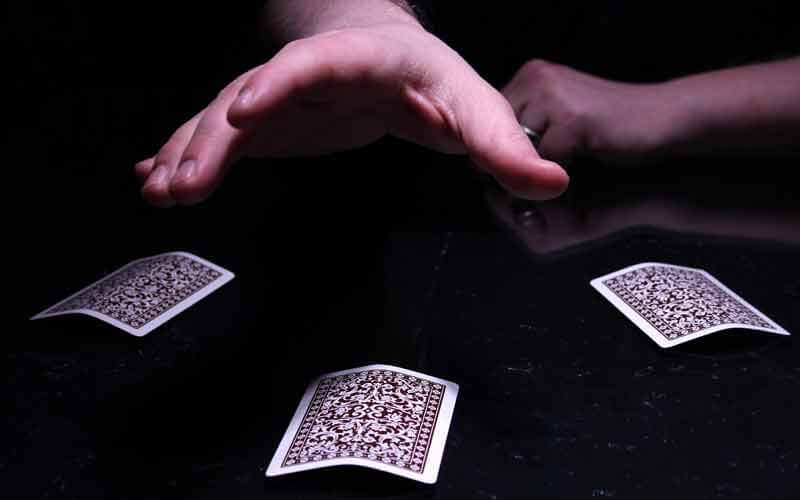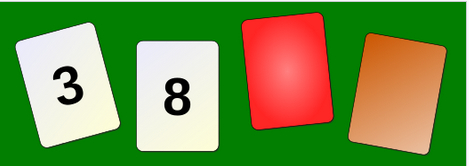Cox and Griggs (1982)
 The following study looks at how we try to solve an abstract logic task and a logic task that is similar to one's life experience. The study looks at both System 1 (intuitive) and System 2 (rational) thinking.
The following study looks at how we try to solve an abstract logic task and a logic task that is similar to one's life experience. The study looks at both System 1 (intuitive) and System 2 (rational) thinking.
 The Wason selection task is a classic in the study of thinking and decision-making. Participants are shown a set of cards and asked the following question: Which card(s) must be turned over to test the idea that if a card shows an even number on one face, then its opposite face is red?
The Wason selection task is a classic in the study of thinking and decision-making. Participants are shown a set of cards and asked the following question: Which card(s) must be turned over to test the idea that if a card shows an even number on one face, then its opposite face is red?
To answer this question, you have to employ the following logic:
- If the 3 card is red, that doesn't violate the rule. The rule makes no claims about odd numbers.
- If the 8 card is not red, it violates the rule. So, this card is a correct choice.
- If the red card is odd, that doesn't violate the rule. The rule is not "if the card is red on one face, then its opposite side is an even number."
- If the brown card is even, it violates the rule.
If we write the logical statement as "if p, then q", then the correct cards are always "P" and "not Q".
However, when Wason originally did his research, he found that on average less than 10% of participants chose the correct cards. He argued that this was due to matching bias - a cognitive short-cut that tends to focus attention on evidence containing the letters and numbers mentioned in the rule. In the example above, "even number" and "red." In other words, we rely on intuitive thinking (system 1) rather than trying to employ more rational thinking (system 2).
Wason (1968) found that even when he trained people how to answer this question, the same mistakes were made.
Griggs and Cox, however, argue that the Wason selection task may not really show how we make decisions because it is too abstract and this type of task is outside of the experience of most people. Instead, they propose that when the context of the problem is familiar, then participants make decisions based on relevant past experience, rather than on the card's logical status - what is known as the memory-cueing hypothesis.
The aim of Griggs and Cox (1982) was to see if matching bias was less commonly used to solve the Wason Selection Task when the task was more personally relevant.
Their sample was made up of 144 undergraduate psychology students at the University of Florida. The participants were randomly allocated to one of six groups in order to counterbalance the experiment.
Each group was given a workbook with three problems. Each group had a different order of the questions.
For each of the following statements, they were asked which cards they would have to turn over in order to prove if the following statement is true.
Task 1. The Abstract Task
If a card has an A on one side, then it has a 3 on the other side.

Task 2. The Intermediate Task
If a person is wearing blue, then the person must be over 19 years old.

Task 3. The memory cueing task
If a person is drinking beer, then that person must be over 18 years old.

The researchers found the following results:
- Abstract task: 5/144 (3%) solved the task correctly.
- Intermediate task: 62/144 (43%) solved the task correctly.
- Memory cueing task: 87/144 (60%) solved the task correctly
They also found that when the participants were given the abstract task first, there was an increase in the use of matching bias in the other conditions. It appears that when the task cued memory of past experience, a more rational approach was taken to choosing the cards. The more abstract and less relevant the task, the more likely that cognitive biases would be used to solve the problem.
Another example of how memory-cueing tasks may influence decision making is seen in a study done by D'Andrade (as cited in Rumelhart, 1980). Participants were asked to imagine that they were managers in a department store and were responsible for checking receipts to determine whether the following rule was followed: If a purchase exceeds $30, then the receipt must be approved by the department manager.
They were then given the following cards.

On this task, the researchers found that nearly 70% of the participants chose the correct cards ($45 and unsigned). This supports the argument of the memory-cueing hypothesis that when the situation is something with which participants have some familiarity and experience, the matching bias is avoided.
Both the Wason Selection Task and Cox and Griggs' (1982) study have been replicated, meaning that the findings are reliable.
The procedure is highly artificial and may not represent how we make decisions in real-life situations. The studies lack ecological validity. There are many factors that are not accounted for, including the importance of the decision or the role of others in making the decision. We often do not make decisions in isolation.
Cox and Griggs used a repeated measures design. This controlled for participant variability. In addition, they counter-balanced the conditions to control for order effects.
Both Wason and Cox & Griggs used samples made up of undergraduate psychology students. Since they are university students, we may assume that they are above average intelligence. This sampling bias means that the samples are not representative of the general population.

 IB Docs (2) Team
IB Docs (2) Team
